

Midsummer Greetings: From Me to You
|
During the New Year, Japanese send and receive a flurry of New Year cards known as nengajo (年賀状); these cards, usually decorated with the zodiac animal of the year, enquire upon the receivers’ health and ask for continued strong bonds in the coming year. But did you know that greeting cards are exchanged during the summer too?
A little-known Japanese summertime custom, shochumimai (暑中見舞い) cards are midsummer greeting cards sent to family and friends. Starting at the end of the rainy season in late July, people send cards to ask after each other’s health during the hottest time of the year. Summers in Japan are hot and humid. Temperatures regularly soar to 30-32 ºC in the daytime, with nighttime temperatures staying warm especially in urban city centers. The heat, combined with high humidity levels, poses a risk of heatstroke and other heat-related illnesses during this time of year. Lethargy and loss of appetite can also be attributed to the relentless heat too. Shochumimai greeting cards are thus a good way of reaching out to your acquaintances and reminding them to take care of themselves. Although sending these greetings through slow mail may seem like an outdated method of communication, especially when messages can be fired to the receiver immediately through messaging and social media apps, these cards are much appreciated for their ability to convey the sender’s feelings of care and concern with a touch of nostalgia. |
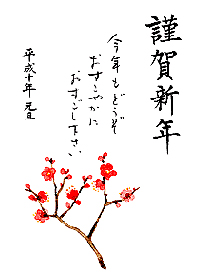 © Web Japan 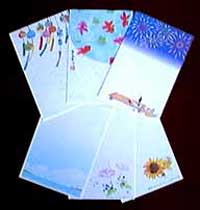 © Web Japan |
|
In line with the season, shochumimai greeting cards are usually decorated with summer-themed motifs. Cards may sport illustrations of food like shaved ice and watermelons, or items like fans and wind chimes. Illustrations of the ocean and fireworks are common as well.
When writing a shochumimai card, the following phrases are essential. Firstly, the title of the letter should read: 暑中お見舞い申し上げます。 This title is generally translated as “summer greetings to you,” but its meaning can encapsulate additional meanings such as “best wishes for the summer season,” and “wishing you a healthy summer.” The body of the message is where you should enquire on the receiver’s safety and health, and share recent updates about yourself and your family. The following are some phrases can be used when writing your own greeting card: 猛暑が続いておりますが、いかがお過ごしでしょうか。 Shochumimai greeting cards can be sent from mid-July up till 7th August. This is the day before risshu (立秋), which marks the first day of autumn. After this date, greeting cards can still be sent, but they are now referred to as zanshomimai (残暑見舞い). Although illustrations for zanshomimai greeting cards also draw from summertime aesthetics, the messages differ slightly from shochumimai cards. For example, the card should open with this phrase instead: 残暑お見舞い申し上げます。 Like the shochumimai, the body of the zanshomimai should enquire on the health of the receiver and wish them well, but different phrases are used to reflect the gradual change of seasons. For example: 炎暑が続き本当の秋が待ち遠しい毎日ですが、お元気でいっらしゃいますか。 |
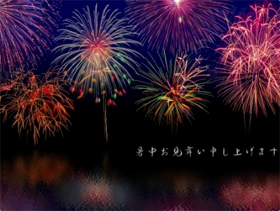 © photoAC 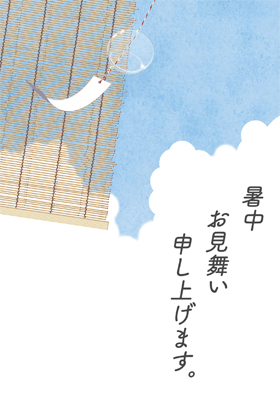 Image made with a free image from Japan Post website 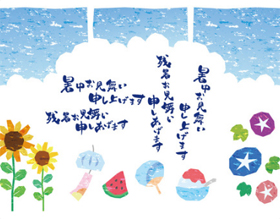 © illustAC 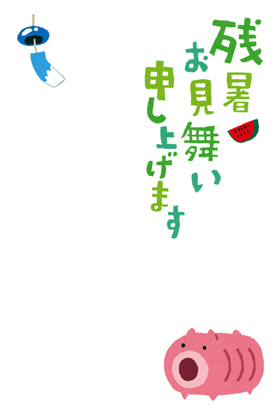 © Irasutoya |
|
‘Shochū Omimai Mōshiagemasu’ is also the title of a famous and well-loved pop song. It was released in 1977 by Japanese pop idol trio Candies, and was a hit in the summer that it was released. With an upbeat tempo and lyrics that describe familiar summer scenes and the feelings of wanting to meet a loved one, it is a song that many Japanese think of in the summer even till today!
While it remains difficult for us to visit our family and friends during this time, it may be nice to express our care for them through a handwritten card. So, why not try sending them a handwritten midsummer greeting card? |
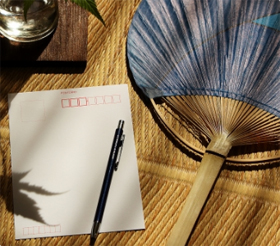 © photoAC |
Resources
|
Japanese Summer Customs | The Expat's Guide to Japan. (2019). Retrieved 15 June 2020, from https://expatsguide.jp/articles/culture/japanese-summer-customs/# |
|
Japan Creative Centre 4 Nassim Road, Singapore 258372 +65 6737 0434 / jcc@sn.mofa.go.jp https://www.sg.emb-japan.go.jp/JCC/ Nearest parking at Orchard Hotel & Delphi Orchard |
 |